What is Passive House?
Introduction
Passive House (also referred to as Passivhaus) is a standard and a scientific design tool that achieves exceptionally comfortable and healthy living and working conditions combined with low energy demand and minimal carbon emissions. It can be used for all building types, including very low-cost buildings. The techniques work for both new and refurbished buildings of all types and sizes. The Passive House method has been successfully applied and tested across all European climates, the US, Canada and even in warm Asian climates where there is a cooling requirement. Indeed with some regional variations of the design techniques, the method has been shown to be applicable almost all around the world. The design techniques originated in the central European climate with its very cold winters, but local weather data is always used to tune passive buildings into their precise location, and performance monitoring has shown that Passive House is ideally suited to the milder climate of the British Isles.
A Passive House building is one in which thermal comfort (as described in international standard ISO 7730) can be provided by post-heating or post-cooling of the fresh-air flow that is required for good indoor air quality, as defined by DIN1946. This is achieved without recirculating used air which even now remains common practice in most air-conditioned office buildings (W. Feist: Passive Houses in Practice. Bauphysik Kalendar, Ernst & Sohn, Berlin 2007).
This definition doesn’t contain any arbitrary numerical values, and is valid for all climates. It is a fundamental concept and not a randomly set standard. The concept requires the use of precise technical methods, which are based upon the science of building physics.
Passive House delivers much of its comfort and very low energy costs by means of insulation and draught-free construction. If a building isn’t ventilated by draughts, then it must be ventilated by another means and a passive house uses heat-recovery ventilation to provide ample fresh air in winter, when the windows are closed, without wasting energy from cold draughts blowing through the building. An ordinary building also extracts stale air directly to outside, wasting all the heat contained in the air. In a passive house, the extracted air gives up most of its warmth to the fresh air supply. The supply of healthy quantities of fresh air without wasting energy is sometimes described as “hygiene ventilation”. Winter warmth is also partly provided by passive use of solar energy and partly by making use of internal heat sources such as people and appliances. After all this, the resultant annual heat demand is tiny by comparison with an ordinary building.
Passive House methods provide an accurate way of designing buildings. Using the Passive House Planning Package (PHPP), developed by the Passivhaus Institut (PHI) in Germany, a good designer and builder can create comfortable, healthy, economical, environmentally friendly and affordable buildings.
The methods were first tested and proven in the Europe-wide CEPHEUS research programme. Outstanding results have also been found within the current Building Performance Evaluation programme funded by the UK’s Technology Strategy Board. Test results show that Passive House buildings create the perfect conditions for living comfortably, healthily and cheaply, with minimal energy demands, whatever the weather is doing outside.
New window inventions, heat-recovery ventilation products and other manufactured products have been stimulated by the uptake of Passive House methods across Europe. Alongside the uptake of Passive House methods, it is only a matter of time before suitable high-quality products from local manufacturers appear; supporting and regenerating the local economy. More can be learnt by referring to Passipedia, at: www.passipedia.org
The origins of Passive House – how and why it began
After the forests of Europe had been mostly destroyed for agriculture and firewood, Europeans turned to coal for fuel as the Industrial Revolution started. But where coal wasn’t available, other ideas emerged. For example Icelandic people turned to burning peat in their turf-walled and turf-roofed houses. For stability the walls were very thick, and these turf walls were found to have good insulating qualities so that hardly any heating fuel was required. These Icelandic homes were a simple form of early passive house. There are many other similar stories of the discovery of passive building techniques around the world, especially in some of the world’s gentler climates, but the real challenge that began to be addressed by researchers from the 1960s onwards was how to replicate this passive performance in European and North American buildings where people had steadily rising comfort requirements and consequently very high winter heating demands.
In Sweden during the 1960s, a civil engineer named Bo Adamson carried out research on highly insulated buildings and built a first prototype development to test his ideas at Alhem. By the time of the oil crisis in 1973, and partly due to Adamson’s work, Swedish buildings were relatively energy efficient compared to buildings in most of Europe, and by the mid-1980s low-energy design had become a legal requirement (SBN80 Swedish Building Regulation 1980) for new buildings in Sweden and Denmark. Also at this time, Adamson was teaching holistic design methods to architecture students at the Faculty of Engineering at the University of Lund in Sweden, where he was at the same time working on further developments in insulation, thermal bridging, insulated glazing, airtightness and controlled ventilation. Adamson’s ambition was to find a way of building that required no heating at all. To achieve this aim he assumed that it would be necessary to allow temperatures to drop to perhaps 17°C in a Swedish winter.
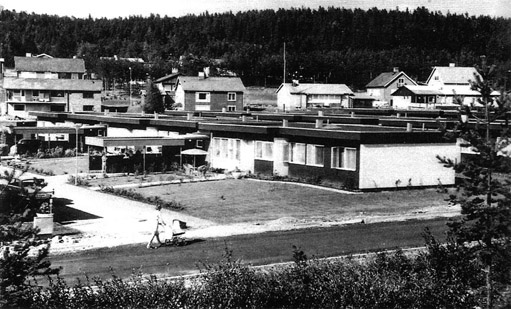
Project of 32 houses in Alhem, by Bo Adamson for Skellefteå Power
This was the approach Adamson took on a theoretical project in China in 1986–7 when he collaborated with the Chinese Ministry of Construction on a feasibility study of passive houses in southern China. It was illegal to heat buildings south of the Yangtze river at that time, so his proposal had no heating but high levels of insulation, high build quality and triple glazing. New houses at the time had indoor temperatures as low as freezing point during the winter, and Adamson was asked by the Chinese government to carry out research on passive houses with the aim of suggesting ways to improve the indoor winter temperatures of unheated Chinese buildings. The results of his research, a publication on passive and low-energy houses in southern China, can be found in the BKL construction library, Report TABK—92/3006, 1992.
Dr Wolfgang Feist – “the father of Passive House”
Meanwhile during the 1980s Wolfgang Feist, a young German physicist with a master’s degree in Quantum Mechanics and later a Doctorate in Architecture, was carrying out low-energy building research with the aim of finding a method to create very low-energy passive buildings which did not compromise on the warm indoor temperatures and general comfort that people in Europe had become used to. Feist felt that maintaining people’s comfort was essential if people were to be convinced by the proposal to save energy, and in this respect his approach differed from the approach taken in China. Feist quantified the energy losses in a building, to minimise those losses and to quantify the resulting energy requirements to maintain 20°C, after using all the free heat gains available.
Feist visited Sweden frequently throughout the 1980s to share his ideas with Adamson. This appears to have been an exciting time in which the two men systematically and urgently laid the foundations of the Passive House concept. Feist’s work involved computer simulation of the heat balance of a building, hour by hour during a typical year. He was looking for a robust methodology to apply to all forms of building, guaranteeing the highest level of comfort while using only negligible amounts of energy. It was clear from the beginning that the Passive House concept had to be cost-effective. This is why Feist and Adamson concentrated on the building envelope. Walls and windows are fundamental components of buildings, so improving them is a cost-effective starting point. Moreover, if improvements to the fabric are made by means of industrial manufacturing processes, the resulting efficiencies act against price increases. An example of this is that the cost of triple glazing in mainland Europe is now only €12 per square metre more than double glazing after starting off costing €80 more.
In May 1988, while working at Lund with Bo Adamson, Dr Feist launched the definition of “the Passive House”. Passive Houses were defined as: “buildings which have an extremely small heating energy demand even in the Central European climate and therefore need no active heating. Such houses can be kept warm “passively” by using the existing internal heat sources and the solar energy entering through the windows as well as by the minimal heating of incoming fresh air.”
By 1989 Dr Feist completed his work in thermal building simulation at the University of Kassel and immediately formed a small consortium to fund and build the first test-project; a Passive House apartment block at Darmstadt Kranichstein.
Over 20 years of monitoring of the four completed dwellings has shown that the pilot project has consistently achieved 90% annual energy savings compared to the German Building Code of 1995, while maintaining excellent comfort and exceedingly healthy living conditions.
After the outstanding success of the pilot project, Dr Feist founded the Passivhaus Institut in 1996, in Darmstadt, Germany to research energy use in buildings, to develop design tools such as the Passive House Planning Package (PHPP) and also to be the scientific head of the CEPHEUS EU-wide building trials (1997).
Wolfgang Feist emerged as the father of the Passive House movement because he developed the scientific foundations of the standard and then went on to form the Passivhaus Institut. Feist, more than anyone, tirelessly works both scientifically and politically to explain the clear social and economic benefits of the standard in a way that can be understood by everyone. He has always been realistic about the challenges, political and financial, that will be faced by such a socially liberating movement. A solution that reduces energy consumption, even though providing clear benefits to people and the environment, will not be championed by those who profit from poor-quality construction or by those who see energy efficiency as a threat to business-as-usual. Nevertheless Dr Feist is successfully leading a worldwide revolution that has the potential to put power and security back into the hands of local communities.
The pilot Passive House building
In 1989, Dr Feist brought together a team of three private individuals and an executive architect in order to test the practical feasibility of the Passive House concept by means of a pilot Passive House building at Darmstadt Kranichstein, Germany. A scientific research group was formed and the research included developing:
- an efficient heat-recovery ventilation unit
- new specially insulated window frames and blinds
- construction details for the connection of building components
- solar heating technologies and a concept for heat recovery from waste water
The house was given extremely good insulation and efficient heat-recovery ventilation, and achieved a pressurised n50 air test result of less than 0.3h-150. The energy-monitoring results proved that the strategies were very successful. The measured net energy consumption (space heating + domestic hot water + electricity), averaged across the four houses, showed that the buildings required almost no heating at all (below 10W/m2). This represented a saving of 90% compared to the German Building Code of 1995. The pilot houses also required much less energy for domestic hot water and electricity than an ordinary dwelling due to solar water heating and very efficient electrical systems and appliances. Dr Feist and his family are so happy with the great success of the project that they still live in one of the four houses.
The theoretical proof for the feasibility of such houses was provided in Wolfgang Feist’s thesis Passive Houses in Central Europe (1993), in which he analysed the characteristics of each building component by means of computerised simulations. For example, in his thesis Feist demonstrated how the then new technology of lowemissivity coatings in triple glazing enabled large glazing areas to reduce the annual heating needs of a European house, assuming a very draught-free construction.

The pilot Passive House building, Darmstadt Kranichstein, 1991
Testing the concept at scale – the CEPHEUS project
Building upon the success of the pilot scheme, in 1997 a second, larger project of 22 very low-cost Passive Houses was built at Wiesbaden. In fact, they were the lowest-cost houses built in the town at the time. Subsequently, 32 low-cost passive houses were built at Hanover Kronsberg under the programme known as Cost Efficient Passive Houses as European Standards (CEPHEUS).
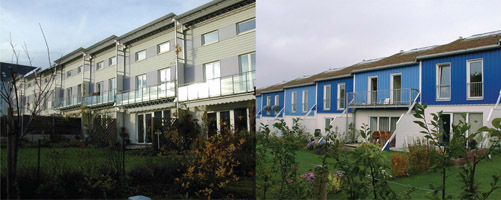
On the left, Wiesbaden low-cost Passive House homes, 1997 On the right, Hanover Kronsberg low-cost Passive House homes, 1998
Five countries (Germany, France, Switzerland, Austria and Sweden) were involved in this first large-scale performance test of cost-efficient passive houses. Fourteen different projects, comprising a total of 250 passive house dwelling units, were built in the CEPHEUS programme.
In-use energy monitoring was carried out in 114 of the CEPHEUS dwelling units. The average specific heat demand was found to be 16.6kWh/m2/yr. Some households naturally used more energy than this, and some used less. The resulting ogee or S-shaped curve of the graphed data is not exclusive to passive houses. The same shape of graph, but with a much wider distribution of results, was found to apply to ordinary German Building Code houses. Comparing both sets of results revealed that the average annual heat-energy consumption of a passive house home was about one-tenth that of the average use of an equivalent ordinary German Code home, or one-fifth of the average use of an equivalent “low-energy” German Code home.
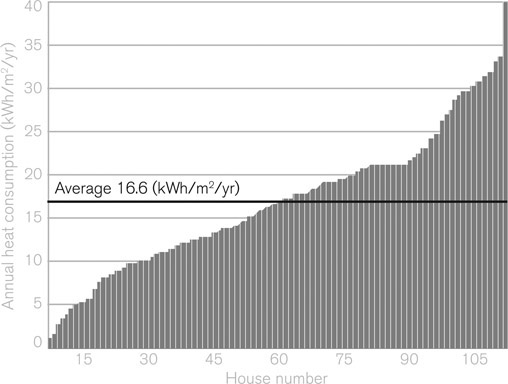
The CEPHEUS programme – average heat energy use was as predicted
The impact of building users on design energy targets
When the CEPHEUS results for passive house buildings were plotted on the same graph as older buildings and those classified by the German Building Codes as “low-energy buildings”, it was found that even the highest consumer of heat energy in a passive house building used less energy than the lowest consumer in a “low-energy building” as defined by the German Building Code.
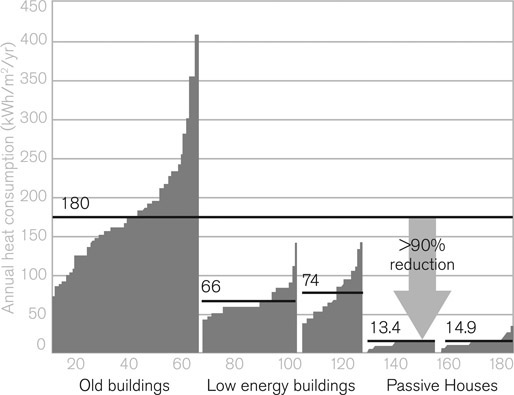
The CEPHEUS programme found that even the highest consumer of heat energy in a Passive House building always used less energy than even the lowest consumer in a “low-energy building”
The CEPHEUS energy-performance results illustrated the benefit of the Passive House method in robustly bringing down the running costs of a building, almost regardless of occupant behaviour patterns. While it is clear that building users do have an impact on energy use in a Passive House just as in any other type of house, the CEPHEUS findings showed that the “Performance Gap” is closed because the impact of a user upon the designed energy use of a Passive House is much less than the impact of a user upon the designed energy use of an ordinary building (Ref: CEPHEUS Final Report. Passive House Institute/Stadtwerke Hannover, 2001; Scientific guidance and evaluation, PHI 2001).
The economic foundations of Passive House
The Passivhaus Institut (PHI) in Germany has based the economic foundations of the Passive House standard on “capitalised costs” alternatively referred to as “lifetime costs”. Here is an introduction to the theory. (Also, refer to page 29 for futher information on the “whole-life cost” of Passive Houses in the UK.)
It could be argued that the problem of low-energy buildings is that a reduction of energy consumption is achieved only at the additional cost of enhanced building quality (eg extra insulation, more panes of glass in better-quality frames, greater care to achieve better airtightness, better-quality materials and more energy-efficient ventilation systems).
However, the capital cost of a building is only part of the lifetime cost of a building, and if energy costs to run the building over its lifetime are considered there are lifetime cost advantages in spending some extra money on the construction of the building. The question is what is the optimum formula for the lowest lifetime cost?
When the theory of the economic foundations of Passive House was formulated in 2001 it was calculated that the energy-saving benefits of an ordinary low-energy house, based on 2001 energy prices, was found in a building that consumed around 40–50kWh/m2/yr specific space-heat demand. Reducing energy demand further was not justified from the point of view of economics alone, because it simply increased the whole-life cost of the home.

For conventional construction, the lowest lifetime costs are found in a building that requires 40–50kWh/m2/yr heat energy
However, a Passive House was found to change this conclusion because, since the peak winter heat-energy demand in a Passive House is so low, a Passive House does not need a conventional heating installation. It was calculated that, using local weather data, it is possible to deliver sufficient heat to maintain steady indoor winter temperatures of 20°C in the coldest days of winter by means of the heat-recovery ventilation system.
The capital cost savings that result from this approach bring down capitalised or whole-life costs, with the result that the lowest whole-life cost was found in a Passive House building that consumed just 15kWh/m2/yr specific space-heat demand.

For Passive House construction, the lowest lifetime costs are found in a building that requires just 15kWh/m2/yr heat energy
Since 2001, when interest rates were still at 5% and energy costs in Europe only 4 cent/kWh, the situation has become even more favourable for the passive house approach. With more up-to-date figures of 3% interest rates and energy costs of 9 cent/kWh, the “conventional optimum” will be 17 or 18kWh/m²/yr specific space-heat demand (roughly the same as a Passive House), without even without taking into account the Passive House cost advantage of simpler systems.
The Passive House solution
The following pages explain the key elements that are normally needed to achieve the Passive House standard.
To be clear, though, Passive House is not a product, nor do certified Passive House buildings need to contain certified products.
Passive House is primarily a technical design method, based on the fundamentals of building physics, and represented by the Passive House Planning Package (PHPP), which is tuned by the architect to the average weather conditions of each building’s location.
Passive House architects are free to develop their own design strategies, as long as they comply with the requirements of building physics, to create warm, comfortable, dry buildings that are also economical to run. The PHPP enables architects to achieve these requirements with as much certainty as physics can provide.
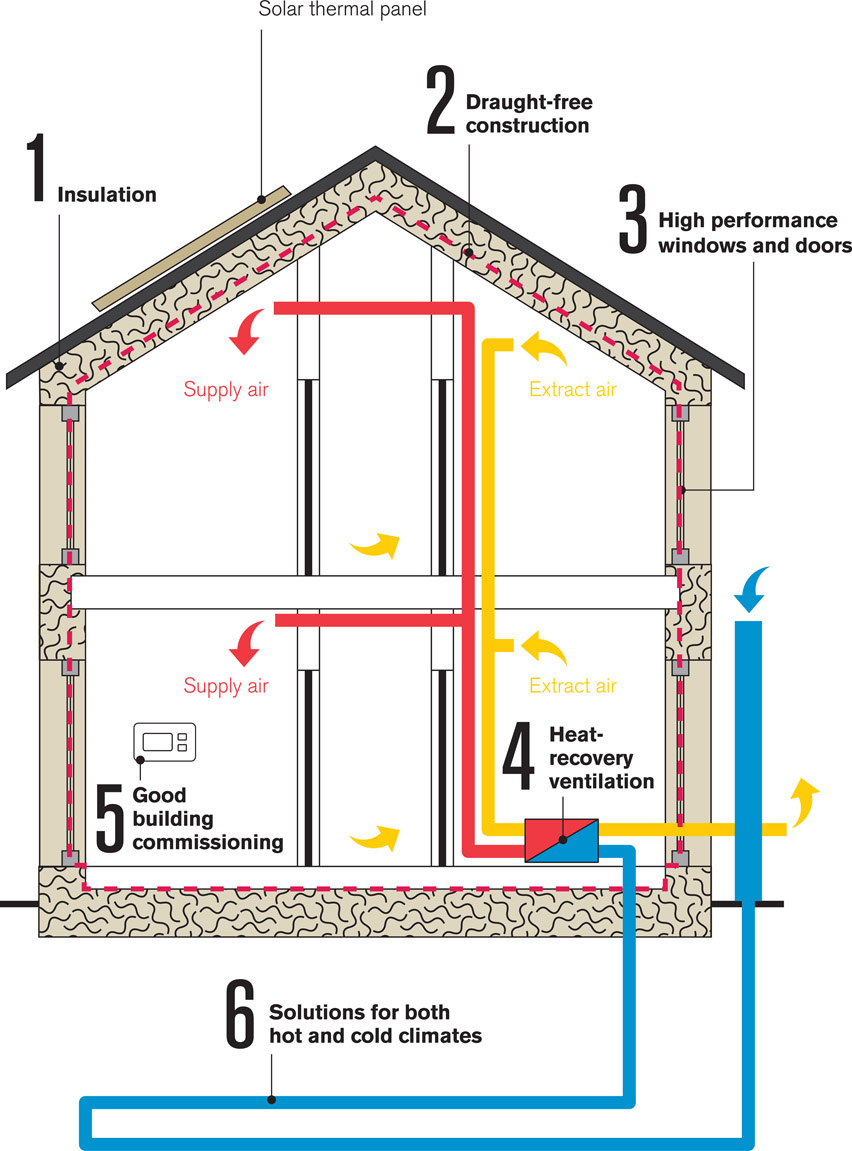
Key elements of the Passive House standard
The key purpose of a Passive House is to achieve a very high level of indoor comfort and health, whilst using very little heating or cooling (maximum 15kWh/m2/yr “specific heat demand”) and very little total energy, taking into account transmission losses from a power station (maximum 120kWh/m2/yr “primary energy demand”).
The Passive House Planning Package (PHPP) contains detailed requirements that must be fulfilled in order to achieve the mandatory comfort, health and energy standards for certification. To achieve all the detailed technical requirements of the PHPP software, the following methods form the essential basics of Passive House design.
1 Insulation

External insulation is typically around 200–400mm thick in Passive Houses in temperate climates. It helps minimise cold bridging and protects the building fabric from thermal stress and from weathering. It can be made from wood or mineral fibres, or from foam boards. It is suitable over masonry or timber construction, and can be finished in a variety of ways, including render or wood.
For a thinner wall or roof, insulation is commonly integrated within timber-framed construction. In this case a breathable insulation made from wood or mineral fibre, combined with vapour-breathable airtightness and weather membranes is a good solution. Well-designed and constructed timber walls need no chemical treatment and are a robust and healthy solution for occupants and the environment.
In retrofit work, internal insulation is often used in order to avoid changing the external appearance of a building. Vapour-permeable wood-fibre insulation at a maximum thickness of around 100mm is widely regarded as a good solution that buffers peak moisture loads in a room while maintaining sufficient vapour drive to avoid condensation within the fabric. This solution does not normally provide enough insulation for a Passive House in a temperate climate, but may be enough for the Passive House Enerphit standard. In 2013 a new vapour-permeable foam insulation product was launched, containing capillary-active straws to maintain vapour-permeable walls and protect against damp and mould growth.
Cold bridging is calculated with proprietary software such as Therm, Heat2, Heat3, Bisco or Trisco, and the results of each external condition or junction in the building are required to be entered into the PHPP software.
As well as fabric insulation, pipework and some ductwork must be very well insulated and mounting brackets should minimise cold bridging. Cold surfaces must be wrapped with insulation that is impermeable to vapour (to avoid condensation on the pipes) but hot pipework can be wrapped in vapour-permeable insulation.

Timber frame is a space-efficient option

Wood-fibre insulation is suitable for interior or exterior use
2 Draught-free construction
Draughts, both from leaky fabric, and from crude bathroom extractor fans, can waste a large proportion of the heat generated to warm a building. Avoiding cold draughts saves energy and improves occupant comfort. If users feel even slight draughts, or cold feet, this may have a range of consequences, from raised heating set-points to switching on local electric heaters. So even subtle draughts from leaky building fabric or primitive “trickle ventilation” gaps in window frames, (both permitted by the UK Building Regulations) may contribute to create a large gap between a building’s design expectations and its actual performance.

Draught-free construction is not as difficult as it is often made out to be. It simply requires care from the design team and care from the construction team. Draught-free construction is as much the responsibility of the architect as it is the responsibility of the contractor.
It is essential for the “line of airtightness” to be considered from an early design stage in order to ensure that the designer makes it reasonably possible for the contractor to carry out a first air test at an early stage of the construction process, and in order to avoid unecessary complications and delays to the construction process. It is essential that the first air test is carried out as soon as the windows and doors are installed and before internal finishes cover over the designated line of airtightness. The reason for this is the simple trick that if the line of airtightness is visible at the first air test, any defects can be found and repaired.
Once a first-stage air test is successfully achieved, any degradation of the air test, usually caused by faulty mechanical or electrical service penetrations, can be monitored and rectified by a second stage or final air test.
With appropriate care and the application of advanced installation techniques, it is easy to achieve airtightness at least 17 times better than the UK Building Regulations normally require. More information on the techniques can be found in Airtightness Report, practical guidance to achieve excellent levels of airtightness in Passivhaus building fabric (available free on the Research page of the bere:architects website).
Once this level of fabric integrity is achieved, it is necessary to be equally careful and methodical in the application of heat-recovery ventilation to maintain hygienic air quality in the winter months when windows normally remain closed.

Using airtightness tapes to fit a window
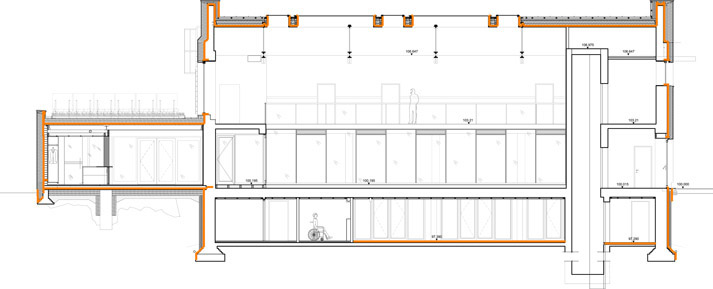
Line of airtightness shown in a general arrangement drawing
3 High-performance windows and doors
The primary reason for very high-quality windows and doors is to provide thermal comfort and eliminate the risk of condensation and mould growth. Triple-glazed Passive House windows are different from ordinary triple-glazed windows in several respects.

Passive House window frames have insulating properties that make them almost as warm as the high-performance glazed component of the window.
Passive House windows are almost totally draught-free. The glass fits into the frames without any air leakage and the frames utilise continuous seals (without joints), usually in two “lines of defence”; they are precision-engineered to fine tolerances and use easily adjustable hinges for fine-tuning of the installation. They use multi-point locking systems in order to ensure that the window is pulled firmly against the seals in the closed position without distortion. This also helps provide superb security.
A Passive House window is designed to maximise solar gains to help warm a building in winter. This is achieved in spite of the three layers of glass, by using unusually clear glass, defined by its “G-value”, which is the amount of solar heat energy that enters through a window as a proportion of the total energy that reaches the window. A higher G-value represents a higher transmission of solar heat into the building. Even the light of an overcast winter day can provide useful gains in a building that hardly needs any heat energy at all.
A Passive House window must be installed correctly. Each certified window design has installation advice to achieve its designed thermal performance. Some window designs rely on being installed in “pockets” which reduce heat loss and make the frames look thinner and more elegant. Windows must be fitted using advanced techniques such as special screws that do not distort the outer frame, and the junction between the window and its opening in a wall or facade system must be absolutely airtight. Twin barriers (usually high-performance tapes) are usually used on the inner and outer faces of frames to control air and moisture movement.
Summer shading may be necessary if the design includes a large amount of glass facing towards the midday or afternoon sun. The PHPP software for the project will highlight if this is an issue of concern. Where it is, it is best achieved with retractable external venetian blinds, but appropriate internal blinds can also reflect about 40% of the sun’s heat, and sliding or folding external screens can also be used for architectural effect.

The Passive House requirement for insulated, airtight window frames has already resulted in a huge outburst of creative energy
4 Heat-recovery ventilation
Heat-recovery ventilation, sometimes described as “hygiene ventilation”, provides plentiful fresh air for both domestic and non-domestic Passive House buildings. This is especially useful in winter so the well-sealed windows don’t need to be opened, completely avoiding cold draughts, condensation and mould growth. Well-designed, installed and commissioned heat-recovery ventilation saves around 90% of the heat in the stale air extracted from bathrooms and kitchens. The recovered heat is put into the fresh incoming air that is supplied to living spaces and bedrooms. It is an energy-saving requirement and is also essential for good winter air quality in a draught-free building (also see page 40).

Once you are used to the concept, it seems incredible that ordinary houses use basic bathroom extractors that throw out precious heated air without saving the heat, and suck icy draughts into the house, while a boiler burns large quantities of fossil fuel to try to put things right! Most ordinary non-domestic buildings are also almost as primitive in their approach to ventilation.
Heat-recovery ventilation equipment consists of tiny, electrically driven, energy-saving fans to gently feed ventilation air through filters and a passive heat exchanger at just the right speed for both indoor air quality and efficient heat recovery. They use only about 35W of power in a domestic application, and over the course of a year can save ten times as much energy as they use. In a house they run 24 hours a day, but in a non-domestic building it is important that they are commissioned to run only during hours of occupancy, otherwise the Passive House primary-energy limit is likely to be exceeded. They are not dependent on wind velocity or thermosyphonic drive as some non Passive House systems are. They operate silently and reliably, removing stale air and filtering out dust.
There is new evidence that heat-recovery ventilation systems improve indoor air quality in urban locations. Airborne particulates are thought to be a cause of heart attacks, strokes and asthma, and in a study carried out by the Institute of Environment and Health at Cranfield University (2013), the Passive House domestic dwelling at 4 Ranulf Road was compared with a conventional house 100 metres along the road, and the Passive House was found to have half the level of fine PM2.5 particulates compared to the conventional house (more information on the Research pages of the bere:architects website).
Both domestic and non-domestic Passive House buildings always supply 100% fresh, filtered, outdoor air to the interior spaces via their heat-recovery ventilation systems. These systems are very different from the recirculation systems used in ordinary commercial buildings throughout the world, which provide an inferior form of heat recovery by means of returning warm, used air back into the building.
While in winter up to 90% of the waste heat is saved by means of a passive heat exchanger, in summer an automatic bypass is often used, and users can feel free to open the windows as they would in an ordinary building.
It is possible that manufacturers will continue to find cost advantages in developing ventilation units that combine with hot-water production and backup heating, and that this will also simplify controls strategies and commissioning and maintenance regimes in the future. In effect these units could become single-point operating units, no more complex or expensive than a washing machine if they are produced in sufficient quantities.

A non-domestic heat-recovery ventilation unit
5 Good building commissioning
An essential part of the design team’s role is to check that the mechanical and electrical systems of a building have been installed properly and are working in the way that they were designed. It is also important to check energy and water consumption and ventilation flow rates once the building is in use. Passive House designers are usually passionate about keeping control systems and user interfaces as simple as possible. Building Management Systems (BMS) are generally considered a completely unnecessary complication. Current research across the full range of non-domestic buildings funded under the UK Technology Strategy Board’s Building Performance Evaluation Programme is revealing that BMS systems are the cause of irreconcilable problems in almost every building being monitored. Of the buildings being monitored, only the Passive House Mayville Community Centre is free of a BMS system and only the Mayville appears to be living up to the performance promised in its design. Passive House is largely about keeping things simple and about quality control!
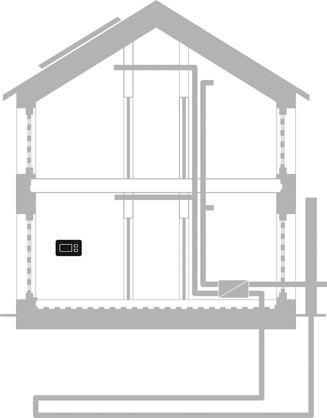
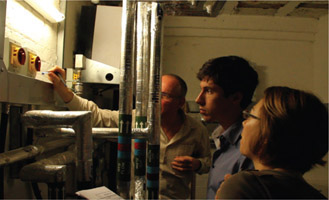
Careful checking of a building’s commissioning can be a satisfying conclusion to a project
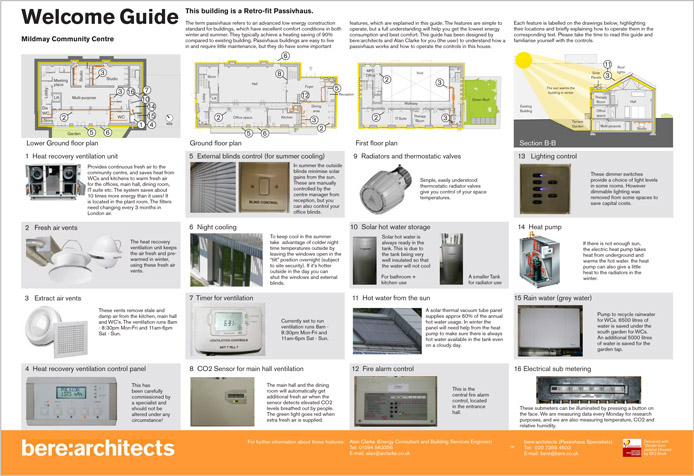
Example of a User Guide to help occupants understand their building
6 Solutions for both hot and cold climates
Passive House techniques are already common in Germany, Austria, Switzerland and Belgium, and well tested throughout Europe including the UK and Ireland. The climate has important differing local characteristics even across central and northern Europe, so it is essential that the correct local climate data is used. But Passive House techniques are applicable globally, and local climate data might for example result in some regions requiring even better windows or other regions requiring less good windows. However, the Passive House principle remains the same – only the details need to be adapted. With appropriate details, Passive House buildings can be used to reduce heating-energy demand in cool climates or to reduce cooling-energy demand in warm climates. In both cases, the governing principle is that the demand is so small that the gentle ventilation system can be used to deliver the necessary energy to provide thermal comfort.

In warm climates, Passive House methods are now successfully being used to reduce the peak cooling load of buildings. Appropriate size and quality of windows, shading and the reduction of internal heat loads by using highly energy-efficient equipment all serve to minimise the amount of cooling energy that might still be needed to supply good indoor air quality.
Increasingly, the Passivhaus Institut is working on prototype projects that are compatible with local building traditions and climatic conditions. Some remarkable projects in warm climates were presented at the 2012 International Passive House Conference in a session dedicated to “passive houses in warm and hot climates”. Papers were presented on the performance of a terraced Passive House in Spain; a new Austrian Embassy in Jakarta, Indonesia; and a Passive House for hot and humid southern China. Friends and former staff have projects under way or planned in hot climates around the world – in Turkey, Oman, Korea and Ghana.
Jürgen Schneiders of the Passivhaus Institut in 2009 produced a useful study called Passive Houses in South West Europe. This was followed in 2012 by a collaborative research publication from the Passivhaus Institut titled Passive Houses for Different Climate Zones. The results of these research projects are also included in the new PHPP 8 release.

A new Passive House in Spain

Passive House Austrian Embassy in hot and humid Jakarta, Indonesia
